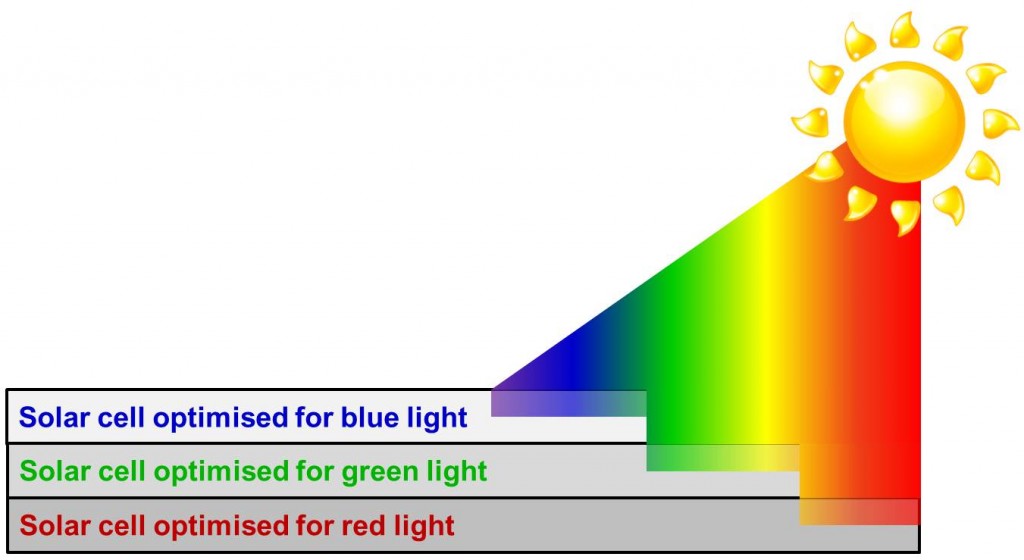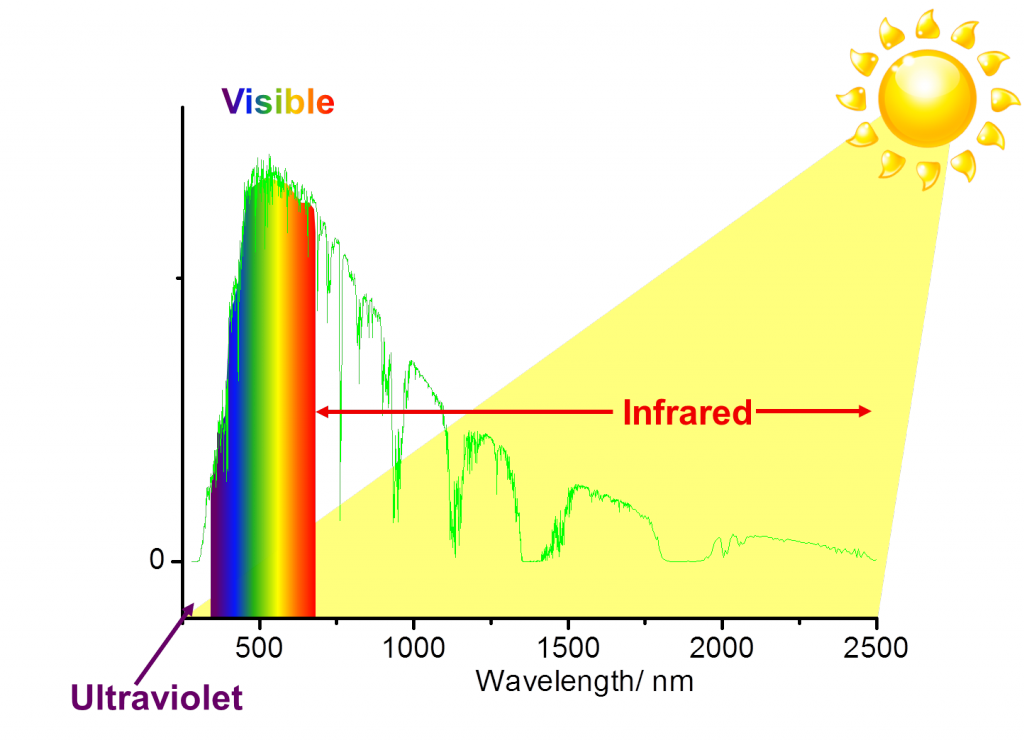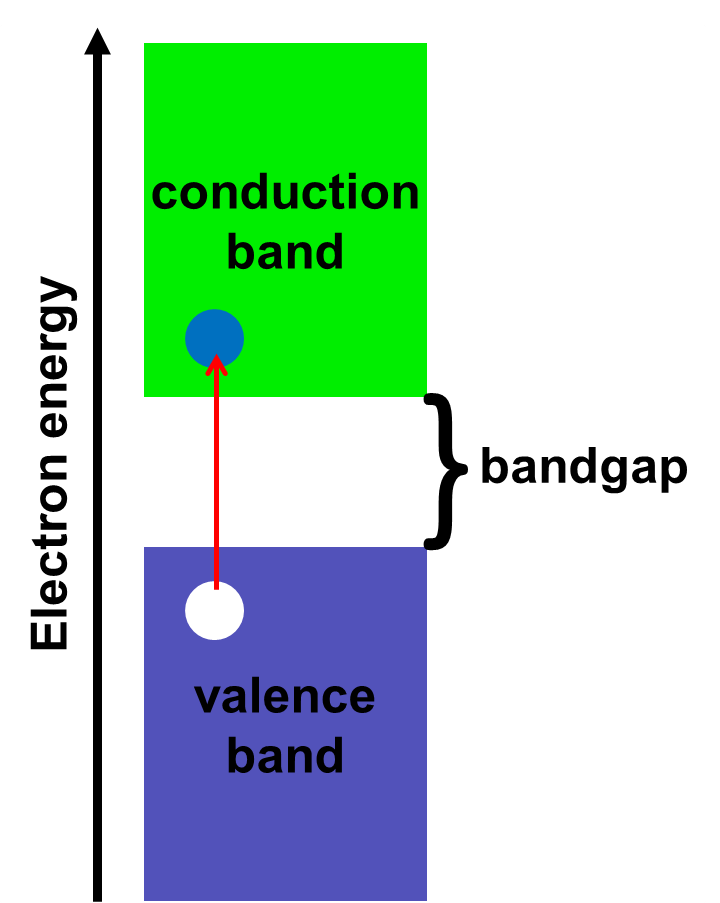What are tandem solar cells?
Tandem cells are effectively a stack of different solar cells on top of each other. By arranging them like this, we can capture more energy from the sun. If, for example, a solar cell is designed to work really well when it absorbs blue light, we could put it next to one that absorbs green light well and one that absorbs red light well so that we can capture more energy from the sun.
If you think about how TV and computer screens are designed, they use a combination of red, blue and green light to be able to make all the different colours you would need. By using all three of them, you can make a white light. In reverse, if we want to collect all the visible white light we want to collect all three colours blue, red and green.
Why use tandem solar cells?
There is a limit to the maximum efficiency that some types of solar cells, known as “single-junction cells” (e.g. silicon), can ever reach called the “Shockley-Queisser limit”. If we look closely at sunlight, we can see that it is made up of photons (particles of light) that have a range of wavelengths, and therefore a range of energies. This is why we sometimes see rainbows when it rains; the water splits up the sunlight into it’s different colours, and each colour has a different wavelength. There are also some parts of the solar spectrum that we can’t see with the naked eye – infrared and ultraviolet light.
Semiconductors, one of the components used in solar cells, have what is known as a “band gap”, which is basically an energy range which needs to be overcome before the semiconductor will conduct electricity. The size of the band gap determines both the energy of light (and proportion of that light) that can be absorbed as well as the maximum power you can get from the cell. The power of a solar cell is determined by the current (related to the number of electrons in the conduction band) and the voltage (related to the size of the band gap). For maximum power, we want both a large current and a large voltage. A large voltage is achieved by having a large band gap, but the bigger the band gap, the higher the amount of energy the photons of light need to have to be absorbed by the semiconductor. If the photons of light don’t have enough energy, electrons will not be able to jump to the conduction band and we’ll get a small current.
So can we just choose a semiconductor with a small band gap? Unfortunately not, for a couple of reasons. Just as photons with too little energy won’t result in an energy output from our solar cell, photons with too much energy aren’t so good either! The extra energy they have is just lost. Also, since the size of our band gap determines the voltage we get out of our cell, we don’t want one which is very small, since this will mean a low voltage and therefore low power output.
It’s a trade off between the two effects; if you change the band gap size to increase the voltage, the current will decrease, and vice versa. It has been worked out that the best balance settles on a theoretical maximum efficiency of around 33%.
Scientists are constantly trying to develop clever ways to overcome this limit, and have already come up with a few possible solutions. Tandem cell solar cells are one example. By using different solar cells which absorb different parts of the visible light spectrum, the value of that theoretical limit can be increased. Other types of solar cells which could do this include Solar Concentrators and Excitonic Solar Cells which use quantum dots.
Stacking the cells
The order of the cells when they are stacked together is important. Blue light has more energy than green or red so the semiconductor material that absorbs it has a bigger band gap.
 The semiconductor material that absorbs red light well has a smaller band gap. This material can also absorb blue light but it is a waste of energy to do so. It is like building a bridge over a tiny stream that you could just step over, a waste of time and effort.
The semiconductor material that absorbs red light well has a smaller band gap. This material can also absorb blue light but it is a waste of energy to do so. It is like building a bridge over a tiny stream that you could just step over, a waste of time and effort.
So to make use of the sunlight most efficiently, the light should reach the blue light absorber first so that this energy can be removed. However, the green and red light will not have enough energy to jump this band gap so they pass straight through to the next layer. Here the green light, the next highest in energy, can be absorbed and the red light can pass on through to a third layer. By doing this, you can get the most out of the sunlight.
Parallel and series circuits
You can also connect the different solar cell layers up in various ways. If you connect them in a parallel circuit you can get more current (rate of electron flow) from the system, and if you connect them into a series circuit you can get more voltage (potential or ‘push’) from the system. How you connect them may depend on what you want to use your solar cells for.




